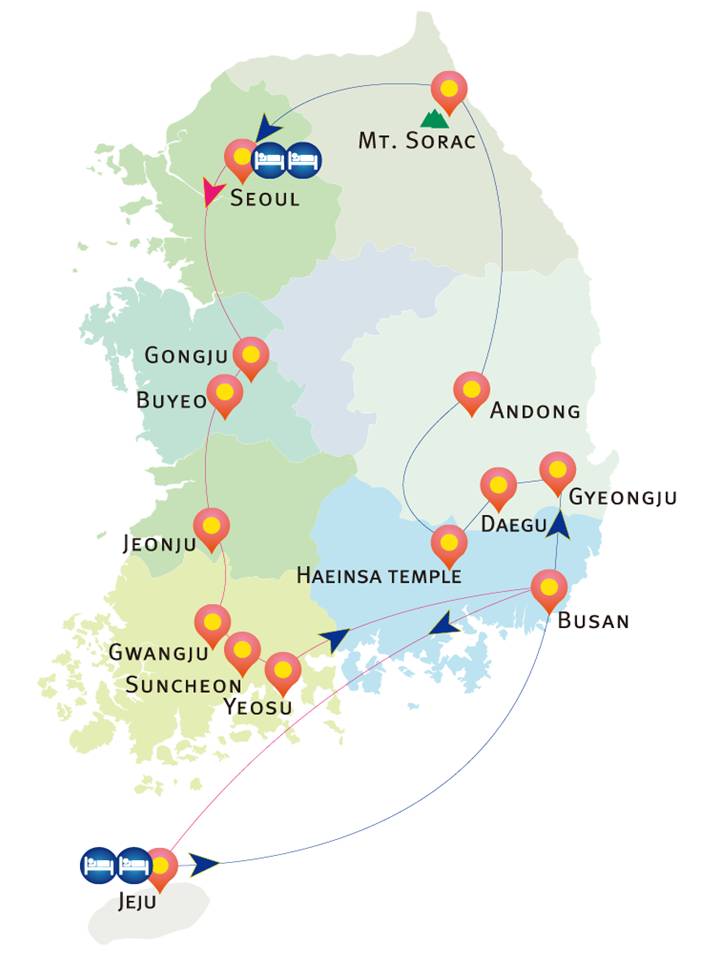
포함사항
호텔, 가이드, 차량, 입장료, 아침&점심식사
불포함사항
국내선 항공권(서울>제주>부산 인당US$230), 옵션 투어 입장료, 개인적 비용, 여행자보험, 저녁식사
** 아래 링크에서 국내선 항공권 예약하실 수 있습니다.(Seoul > Jeju > Busan)
>http://www.gokoreatour.com/korea/tour/package/packageView.html?packageId=PK0000000058
REMARKS
• 성수기 기간에 인당 US$200 성수기 추가요금을 내야 합니다.
• 지정된 호텔과 일정은 현지 날씨, 교통, 대형 행사로 인해 변경될 수 있습니다.
• 차종은 투어 인원에 따라 달라집니다.(밴 : 6명까지, 미니버스 : 15명까지, 대형버스 42명 까지)
• 해당 투어는 한국인 가이드가 영어로 진행하는 그룹 버스투어 패키지입니다.
• 해당 투어는 지정된 요일에, 2명 이상이 되어야 출발 확정됩니다.
• 투어 시 개인적 사고나 손실에 대해서는 보상할 수 없습니다.
• 투어 중 이용하지 못한 부분은 환불 불가입니다.
• 예약 및 변경은 출발일 일주일 전까지 가능합니다.
숙박
• 지정된 호텔과 옵션 사항인 손님 요청 룸타입은 객실 상황에 따라 변동될 수 있습니다.
• 2인 1실 기준 요금으로 1인 손님은 단독 룸 사용비를 지불하셔야 합니다.
• 6세 미만은 침대 제공 없이 일반 요금의 80%로 소아 요금 적용이 가능합니다. 침대를 사용해야 하는 6세 미만 어린이는 일반 요금을 지불해야 합니다.
> 24개월 이하 유아 - 무료 / 3~5세 이하 어린이 - 소아 요금 / 6세 이상 - 일반 요금
> 어른 1명 + 6세 미만 어린이의 경우
• 2인 1실 기준에서 아이에게 침대가 제공되므로 아이에게 소아요금 적용 없이 일반요금이 적용됩니다.
> 어른 1명 + 24개월 이하 유아의 경우
• 유아는 손님 인원으로 카운트 되지 않으므로, 어른이 단독 룸 사용비를 지불해야 합니다.
취소규정
• 일반예약(9명이하) 페널티 : 출발 14일전까지 10%, 13일~8일 20%, 출발 7일 전 100%
• 그룹예약(10명명이상) 페널티 : 출발 4주전까지 20%, 4주~15일전 30%, 출발일 14일 전 100%
OPERATION
• 2019 High Peak Season : 1MAR, 3MAY, 5MAY, 10MAY, 12MAY, 7JUN, 12JUL~30AUG, 4OCT, 6OCT, 20DEC
• 2019 Closing Date : Lunar New Year(3~6FEB), Korean Thanks Giving(12~15SEP)